1864–1865
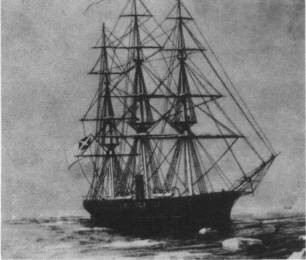
(Armed Cruiser: length 230’; beam 32’; draft 20’ 6”; speed 9 knots; complement 109; armament: 4 8-inch smoothbores, 2 32-pounder rifles, 2 12-pounders; type Shenandoah)
Laid down on the River Clyde, Scotland, as a British troop transport and launched as Sea King on 17 August 1863, Shenandoah was an iron-framed, teak-planked, full-rigged vessel with auxiliary steam power. The Confederate Government purchased her in 1864 for use as an armed cruiser.
On 8 October 1864 Sea King sailed from London for Bombay, India on a trading voyage. There, she rendezvoused at Funchal, Madeira with the steamer Laurel which bore officers and the nucleus of a crew for Sea King along with naval guns, ammunition, and stores. She anchored at Las Desertas, a lonely spot a few miles south of Madeira.
40 year old Lt. James Iredell Waddell, Confederate States Navy, supervised her conversion to a warship in nearby waters. Waddell was born in Pittsboro, N.C. and joined the US Navy in September 1841 as a midshipman. He walked with a permanent limp that he acquired from a duel that he fought with a fellow midshipman, but he stayed in the Navy and was promoted to lieutenant in 1855. Stationed in the Far East when the Civil War broke out, Waddell resigned his commission on 20 November 1861 and made his way home only to find that he was stricken from the Union rolls and wouldn’t receive the last three months of his pay. Appointed a lieutenant in the Confederate States Navy in March 1862, Waddell served as a shore battery officer in Richmond, Va. and Charleston, S.C. until he was assigned to England in March 1863. There he waited until the opportunity for a seagoing posting commanding Shenandoah reached him in October 1864.
After guns were hoisted aboard her, Waddell needed to recruit a crew from the men who manned both Laurel and Sea King. His offers of two months extra pay to enlist in the Confederate Navy convinced only a cabin boy and a fireman. Waddell then lured the men with gold; however only two more sailors were assuaged. In the end, he could only coax another five men to join, so he had in total 19 crewmen and 23 officers making up his crew of 43 to man his new ship. He needed at the very minimum 150 to sail and fight the Confederate raider. Upon council with his officers, Waddell decided to go to sea and try to recruit a sufficient amount of sailors from trophies yet to be taken.
The new cruiser was commissioned on 19 October 1864 and her name changed to Shenandoah. Lt. Waddell read his articles commissioning her and took his ship to sea with an unenviable task confronting him. She was essentially a merchant ship, the decks were crowded with stores, there were no gun ports cut and batteries needed to be mounted. The conversion to a man-of-war was usually performed in a navy yard, not at sea with an inexperienced and very limited crew. When trying to mount the guns it was found that no tackle had been supplied. Without them, if the guns were fired, the recoil would carry them to the other side of the ship with devastating effect. Although the guns appeared through newly cut gun ports threating any ship that approached, it was a threat in sight only since they could not be fired in anger. Waddell in reality had only two 12 pounders that could be fired. He needed to find both new crew members and heavy tackle with which to secure his main armament.
On 28 October 1864 after an already difficult period at sea, a ship was sighted that turned out to be Mogul, a vessel built in the US, but registered in London so she was released. Two days later, a recently constructed ship, the 574 ton Alina of Searsport, Maine, was spotted steaming for Buenos Aires with a load of railway iron and captured. Tackle for the guns and provisions were soon appropriated by the crew of Shenandoah. Also, a large quantity of cotton canvas for sails was found and then the ship was scuttled south of the Azores and west of Dakar.
In accordance with the operational concepts created by the Confederate Navy Department and refined by its agents in Europe, Shenandoah was assigned to destroy Union commerce in areas as yet undisturbed and therefore her mission was the pursuit of merchantmen on the Cape of Good Hope-Australia route and within the Pacific whaling fleet. As she sailed, Shenandoah captured six prizes in quick succession. On 6 November, the cargo schooner Charter Oak, - commanded by Samuel J. Gilman - of Boston, Mass., was captured and burned in the mid-Atlantic. Two days afterward, the cargo bark D. Godfrey of Boston was sunk southwest of the Cape Verde Islands. On 10 November, the cargo brig Susan of Boston was scuttled southwest of the Cape Verde Islands. She was followed two days later by the neutral cargo ship Kate Prince of Portsmouth, N. H. that was bonded for $40,000 and the bark Adelaide that was ransomed for $24,000, filled with Shenandoah’s prisoners and released to Bahia, Brazil. The Confederate commerce raider closed a very active month on 13 November when the cargo schooner Lizzie M. Stacey of Boston was scuttled and fired near the Equator.
Successful operations continued the following month when the whaling bark Edward was burned off Tristan de Cunha on 4 December. Three days afterwards Alina’s crew was put ashore on a local island and Waddell set course towards Cape Town. But Shenandoah’s propeller shaft was making curious sounds and showed problems that could not be cured while underway. At the Cape, the chance of capture by a waiting Union warship was too great, therefore Waddell decided to run 6,000 miles under sail for Melbourne, Australia. This port would no doubt be the last place that a Union ship would be waiting at in order to apprehend his vessel. While she was enroute, on 29 December 1864, Shenandoah sighted the 750 ton bark Delphine of Bangor, Maine sailing without cargo for Akyab to take on a load of rice. Her captain pleaded that his wife was onboard and ill and that removing her could result in her death. In response, Waddell sent his doctor, Assistant Surgeon Charles Lining, to examine the woman in question and he returned to report that she was 26 years of age and in perfect health. Delphine was then quickly fired in the Indian Ocean 960 miles south southwest of India. When her prisoners were brought aboard, six of her crew was persuaded to join Shenandoah’s as she continued to sail east.
Waddell was still short-handed even though his crew had been increased by forced enlistments from prizes when Shenandoah arrived at Hobson’s Bay, Melbourne on 25 January 1865. While at anchor there, she filled her complement and her storerooms and repaired the ailing propeller shaft. She also took on 42 crewmembers who were stowaways from Melbourne. However, they were not enlisted until the ship was outside the legal limits of Australian waters. They took their oaths on the day of Shenandoah’s departure from Melbourne on 18 February 1865. Although her crew was newly augmented, 19 men deserted while in port and some gave statements of their service to the United States Consul there.
Once again underway by her own steam, Shenandoah continued on her assigned mission to destroy Union commerce. During this time, news that yet another Confederate raider was on the prowl broke in both the United States and in Britain. Secretary of the Navy Gideon Welles, who had been overjoyed at finally being rid of the accursed Alabama, was now faced with a new threat in Shenandoah; however he had no idea of her whereabouts or her destination.
Shenandoah then began sailing freely into the Pacific without any signs of Union warships to impede her progress. Waddell decided to sail north towards the Sea of Okhotsk off the eastern coast of Siberia, where the American whaling fleet was known to operate. By the time that she arrived, ice was forming in patches and unlike the sturdy construction of the whalers; Shenandoah was not constructed to act as an ice breaker. Over the next four weeks, there was no sign of a prize until just short of the equator. Whalers often refreshed their water supplies there, so the crew was optimistic they would find their prey. A few days later, Waddell learned from the Hawaiian schooner Pelin that five whalers had recently been seen at Ponape. Shenandoah hurried to the area hoping to catch that fleet before it sailed north.
On 3 April 1865, the whaling bark Pearl of New London was run down, captured and put to the torch at Lohd Pah Harbor, Pohnpei Island in Micronesia. The following day, Shenandoah came upon the whaling ships Hector of New Bedford and the 274 ton Edward Carey, of San Francisco, with black plumes rising from her decks, a sure sign that she had just taken a whale. The Confederate boarding party having reported that Edward Carey carried a vast supply of very useful stores, it took nearly two days to remove all of the plunder that included two fine boats to replace Shenandoah’s tired ones. Charts showing the courses taken by whalers were also found among the ships; therefore Waddell no longer had to search blindly for whaling ships. Having been cleared of all useable goods, Edward and Hector were set aflame and left to founder in the harbor. And finally, on 10 April, the whaling bark Harvest, supposedly of Honolulu, was also fired in the harbor.
Three days afterward, Shenandoah departed Lohd Pah Harbor and Capt. Waddell set course for the Bering Sea. Unbeknownst to him, On 9 April 1865, at Appomattox Courthouse, Va., Gen. Robert E. Lee surrendered to Lt. Gen. Ulysses S. Grant. Three Confederate Armies were still in the field, but hostilities were near an end. Four days afterwards, Shenandoah disembarked all of her prisoners except for seven who joined her crew.
On 28 May 1865, on the edge of an ice field, Waddell hoisted Russian colors and at 500 yards fired a salvo across Abigail’s bow. When boarding parties arrived, the acting master’s mate professed to Southern sympathies and 14 of the crew of 35 changed their allegiance and became crewmembers of Shenandoah. Afterwards, the New Bedford whaling bark was put to the torch 620 miles north of the Kurile Islands. As the ice was closing in, and no further whalers were to be found, Shenandoah turned southwards on 6 June and steamed for the Bering Sea. Upon passing Jonas Island ten whalers lay safely behind a field of ice.
The skies cleared on 21 June 1865 and Shenandoah reached the Bering Sea. The following morning, several ships were reported by lookouts and boarding parties were readied for a very lucrative day. Waddell was intent on capturing them all simultaneously. The 495 ton William Thompson was hampered by having a whale lashed to her side and the 364 ton Euphrates wasn’t bothered by the approaching steamer with the Russian ensign flying. Upon finding out the true nature of the mysterious vessel, William Thompson’s master, Capt. Francis Smith, insisted to Waddell that the war was over. Waddell, taking that intelligence as a stratagem of Smith’s to save his ship, had both ships set ablaze northeast of Cape Narrows.
The next targets in Shenandoah’s sights that day were the whaling barks Jirah Swift and Sophia Thornton of New Bedford and the Brigantine Susan & Abigail of San Francisco. All three vessels were quickly overtaken, captured and summarily burned in the Bering Sea. Finally, the whaling ship Milo was bonded for $46,000 and released with the large number of prisoners that had been acquired during the day.
The rich whaling grounds in the Bering Sea between Siberia and Alaska were a safe haven for Union whalers during the war. This prosperous whaling ended in the spring and summer of 1865 when Shenandoah arrived and captured twenty of the fifty eight whalers employed there. These ships were destroyed more than a month after Confederate President Jefferson Davis was imprisoned on 19 May 1865. But Waddell was still unable to secure absolute evidence that all of the Confederate Armies in the field had surrendered and that President Davis was captured. He certainly didn’t want to believe it. He was well aware that if the war was over that he ran the risk of a subsequent charge of piracy.
On 26 June 1865 Shenandoah began an accelerated pace of trophy collection. During that afternoon the 419 ton William C. Nye of New Bedford was captured and set ablaze near St. Lawrence Island in the Bering Sea. The 384 ton Catherine came next followed by the 340 ton Nimrod. As a result, Shenandoah was brimming with 252 prisoners. Many of them were placed into 12 whale boats that were towed behind her. A further two vessels, the 315 ton Isabella, and the 360 ton Gipsey were taken during that busy day. When General Pike was captured, she was bonded for $30,000 and the ever increasing throng of prisoners was placed aboard for San Francisco.
Two days afterwards Shenandoah continued her destruction in earnest. The whaler Brunswick was burned near the Bering Straits Narrows, the whaling bark Congress of New Bedford was fired near Bering Strait, the whaling bark Covington of Warren, Rhode Island, was put to the torch in East Cape Bay near Bering Strait Narrows, the whaling ships Favorite of New Haven, Connecticut, Hillman, Isaac Howland, Martha and Nassau of New Bedford were burned in East Cape Bay in the Bering Sea. The whaling bark Waverly of New Bedford was fired next in the Bering Sea, near the Diomede Islands and the whaling ship James Maury of New Bedford was bonded for $37,600 in East Cape Bay and retained for transporting prisoners to the United States. Finally, on Shenandoah’s last and most lucrative day of captures, the whaling bark Nile of New Bedford was bonded for $41,000 in Bering Strait, loaded with 222 prisoners and sent off to San Francisco.
On 29 June1865, Capt. Waddell took Shenandoah through Bering Strait. On his port side was Siberia and Alaska was in sight to starboard as he sailed into the Arctic Ocean. He had heard a story that only ten days earlier 60 vessels had voyaged this way and he was looking for them, but an impassable ice field blocked the way. He was afraid of being locked into the Arctic Ocean and decided to retrace his steps. Three ships he had released were on their way to California and they would report his activities. It was time to gain the freedom of the open sea.
Waddell finally learned of the war’s end from the bark Barracouta on 2 August 1865. She was steaming for her home port of Liverpool from San Francisco. (Shenandoah was steaming to San Francisco in order to attack it as Waddell believed that it was poorly defended). While she was there, Barracouta received news of the surrender of Gen. Joseph E. Johnston’s army on 26 April, Gen. Kirby Smith’s army on 26 May and the capture of President Davis and a part of his cabinet on 10 May. Capt. Waddell now had his proof that the war was really over.
Upon receiving this information, it was recorded in Shenandoah’s log that “Having received.... the sad intelligence of the overthrow of the Confederate Government, all attempts to destroy shipping or property of the United States will cease from this date, in accordance with the first lieutenant William C. Whittle, Jr; received the order from the commander to strike below the battery and disarm the ship and crew.”
Capt. Waddell and the crew knew returning to a US port would mean facing a Union court with a Northern perspective of the war. They also correctly predicted the risk of being tried and hanged as pirates. Commerce raiders were not included in the reconciliation and amnesty that Confederate soldiers were given. Capt. Raphael Semmes of Alabama escaped charges of piracy by surrendering 1 May 1865 as an army general under Joseph E. Johnston. Semmes’ former sailors surrendered as artillerymen.
Waddell decided to surrender his ship at her unofficial home port of Liverpool. He then lowered his Confederate ensign and the Shenandoah underwent a physical alteration. Her guns were dismounted and stored below deck and her hull was painted to look like an ordinary merchant vessel.
Shenandoah sailed from off the west coast of Mexico via Cape Horn to Liverpool, a voyage of three months and over 9,000 miles. She was being pursued by Union vessels during the entire voyage. She anchored at the Mersey Bar at the mouth of the estuary and waited for a pilot to take the ship up the river and into the enclosed docks. Shenandoah was not flying any flag, therefore the pilot refused to take the ship into Liverpool unless the crew raised one. Therefore the Confederate ensign was once again unfurled and then Shenandoah sailed up the Mersey with the Southern banner fluttering in the breeze. Once there, the captain of HMS Donegal received the last surrender of the Civil War on 6 November 1865.
Shenandoah had remained at sea for 12 months and 17 days, had sailed 58,000 miles and had sunk or captured 38 ships. Most were whalers and two-thirds of them were after the close of hostilities. Waddell took close to a thousand prisoners without a single casualty among his crew. Two men died of disease. The ship was never involved in a battle against a Union Navy vessel, as was Alabama, but instead took unarmed United States merchant vessels. It was an attempt to influence the Union by eliminating a very lucrative source of income which could be used to further advance the cause of the Union Army. Also, it was hoped that these actions would help to disillusion Northerners from continuing to pursue their war upon the South. In the end Shenandoah became the only Confederate warship to circumnavigate the globe.
In 1866 the US took possession of Shenandoah and sold her to the first Sultan of Zanzibar. He renamed her after himself (El Majidi). On 15 April 1872 a hurricane hit Zanzibar and Shenandoah, one of six ships owned by Seyed Burgash, was blown upon the shore and damaged beyond repair. The most feared commerce raider in the Confederate States Navy was no more.
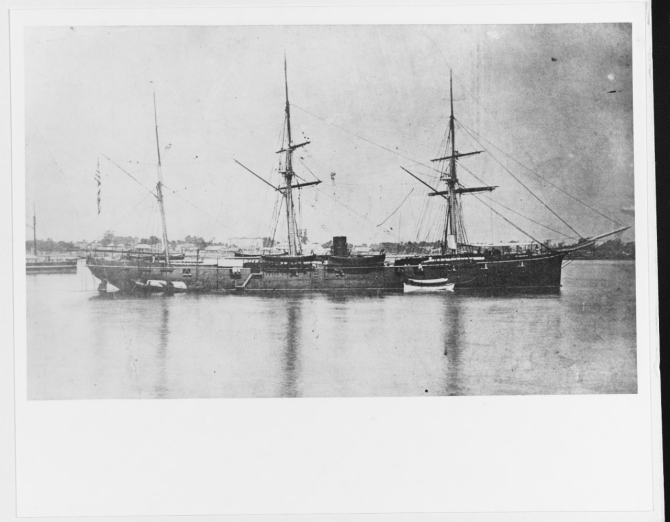
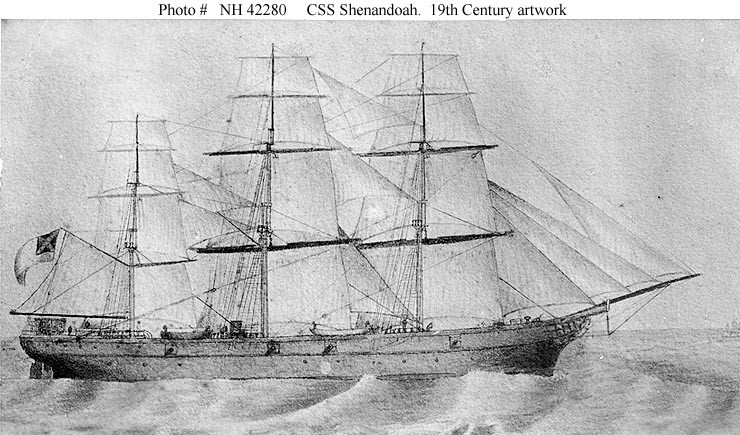
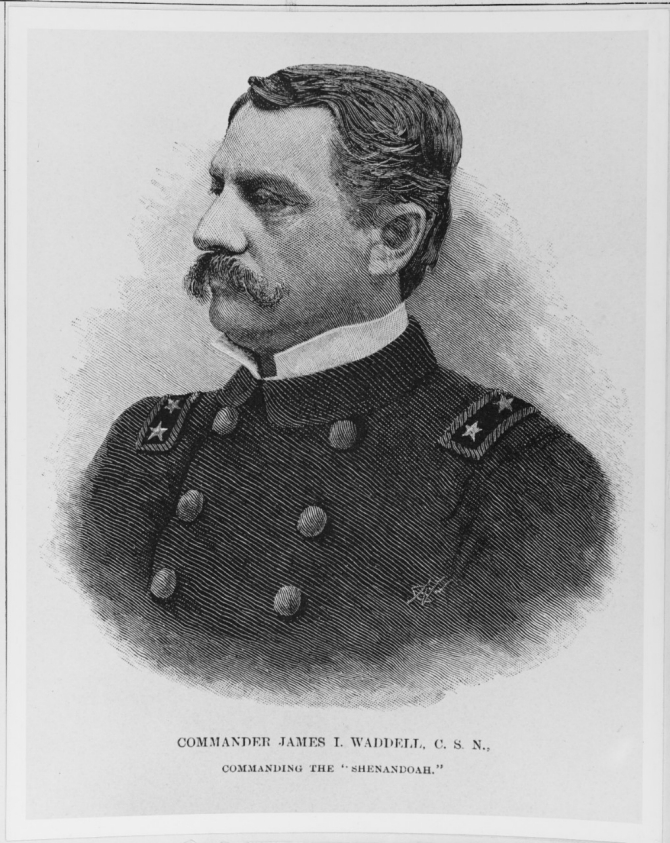
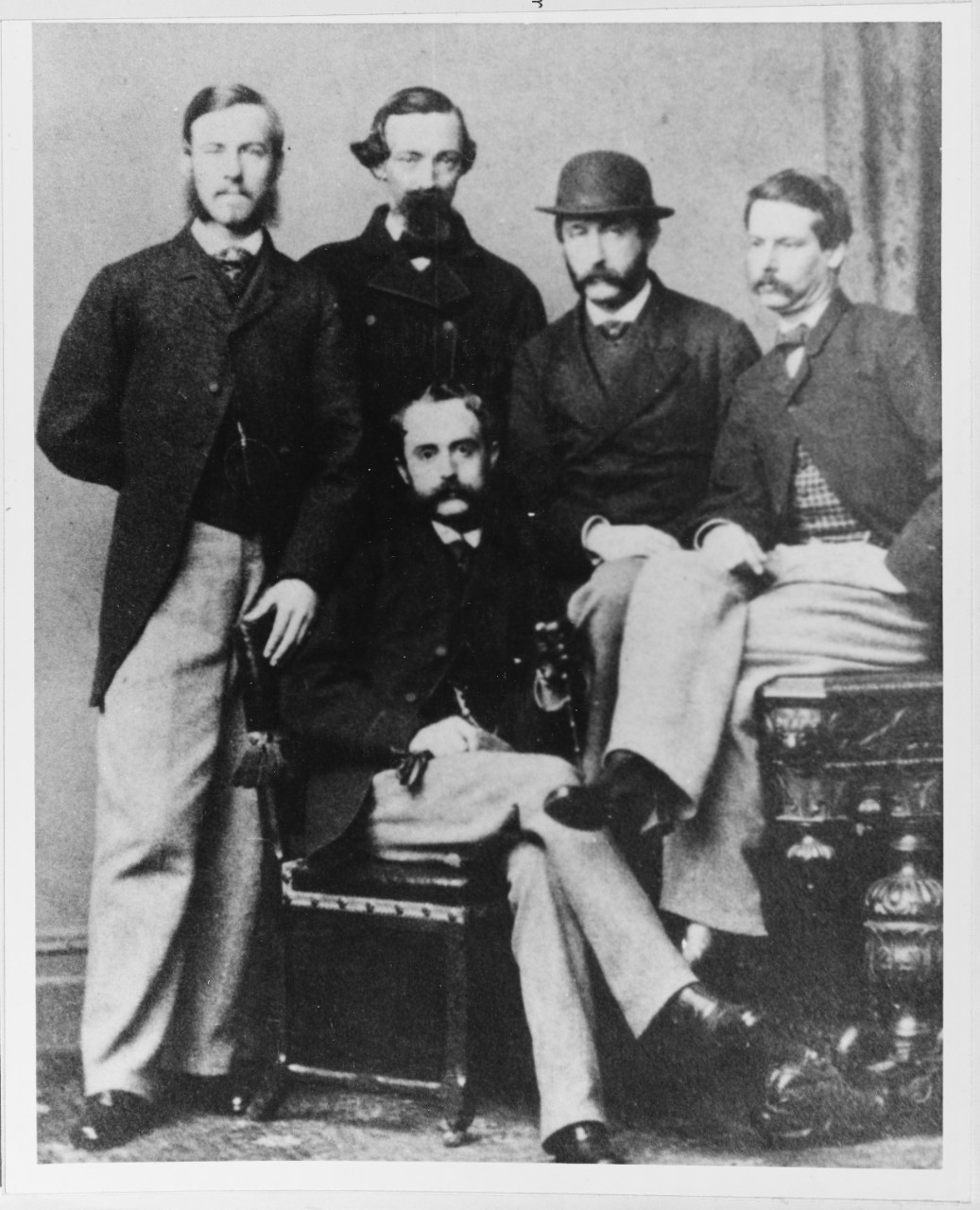
Paul J. Marcello
19 August 2015


